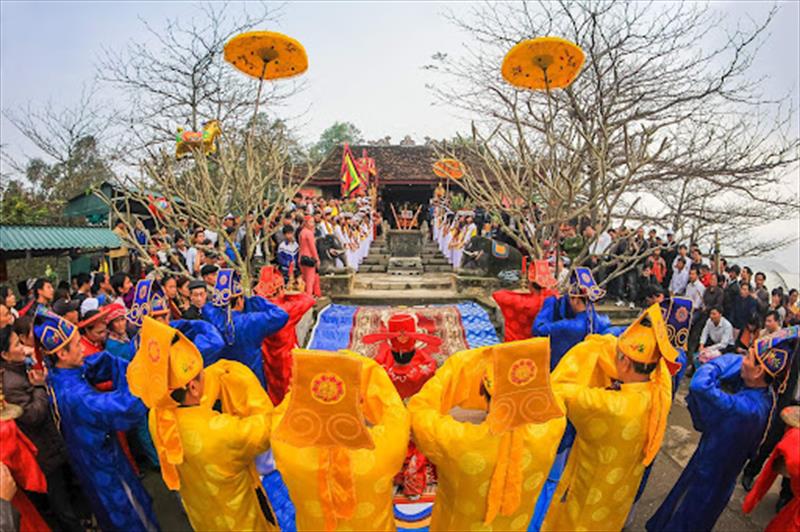The Qua Son Temple Festival in Nghe An Province

One of the most important rituals of the festival is the procession of the deity to thank the Goddess at Ba But Pagoda, also known as Tien Tich Tu Pagoda, located 4km west of the temple in Lam Son commune. According to tradition, Ba But often assisted Ly Nhat Quang with divine intervention in military matters and guided him to the sacred place under Qua Mountain. Every two years, during even-numbered years, a procession is held to thank the deity at Ba But Pagoda. This ritual takes place on the 19th day of the lunar January, starting early in the morning. Young men from the village carry offerings such as fruit, traditional liquor, and square sticky rice cakes from Qua Son Temple to the triple gate, then turn towards Ba But Pagoda. Along the way, the sacred procession is cheered and respected by monks and Buddhists, seeking permission to pass through their homes. After circling Lam Son village, the sacred procession returns to Ba But Pagoda and is placed on the altar.
Another equally captivating ritual is the "winter departure - summer arrival" procession. This is a performance and exchange game between the Han Ly and Hao Khe villages, both associated with the construction of the temple's triple gate in the late 19th century. The triple gate has three entrances: the northern gate with the inscription "Northern territory head," representing Han Ly village to the north; the southern gate called "Southern heaven cave," representing Hao Khe village in the southern cave; and a central gate. On the 20th day of the lunar January, processions from both villages parade from the temple to the triple gate, then exchange places to symbolize harmony and unity. This game also seeks permission from the Holy Monk and the two deities for the construction of the triple gate.
Another solemn and meaningful ritual is the "Heavenly Ascension Ceremony." This ceremony takes place on the 21st day of the lunar January, marking the day Uy Minh Vuong Ly Nhat Quang passed away and ascended to heaven in 1057. During the ceremony, monks and Buddhists recite scriptures, make offerings, and release floating lanterns on the Luoc River to commemorate the virtues of the Holy Monk and pray for the liberation of his soul.
In addition to the rituals, the Qua Son Temple Festival also includes various cultural, artistic, and folk activities such as water puppetry, wrestling, cheo singing, spinning tops, swing games, cockfighting, and Chinese chess. Water puppetry is a unique traditional art of Vietnam, performed on the water by artisans controlling puppets with strings and sticks underwater. The puppets often depict characters from folk tales, agricultural activities, or technical demonstrations. Water puppetry is an art form deeply rooted in the homeland and closely connected to the daily life of the people. Wrestling is a traditional sport of many Vietnamese ethnic groups, organized in the temple courtyard on the afternoon of the 20th day of the lunar January. Athletes compete in a direct elimination format until a champion is determined. Wrestling is not only a strength competition but also an expression of health, determination, and the heroic spirit of the Vietnamese people. Cheo singing is a popular form of folk opera in the Northern region, known for its high entertainment value and reflection of the emotions, sentiments, and life of the people. Cheo is performed by actors with good singing and natural and humorous acting. The plays often revolve around themes such as love, family, society, or history.
The Qua Son Temple Festival is a unique and culturally significant festival in Nghe An. The festival not only helps preserve and promote the historical, cultural, and artistic values of the Qua Son Temple site but also serves as an occasion for people to exchange, unite, and build cultural life in the community. The festival is also an attractive destination for tourists who want to explore the beauty of Vietnam's traditional culture.
The Qua Son Temple Festival is a traditional event of great significance for the people of Nghe An and visitors alike. The festival is not just an occasion to commemorate the merits of Uy Minh Vuong Ly Nhat Quang, one of the bravest generals of Dai Viet during the Ly dynasty, but also an opportunity to pray for favorable weather, abundant harvests, and the well-being of the people. The festival also features many exciting and unique cultural, artistic, and folk activities, reflecting the identity and spirit of the people of Nghe.

